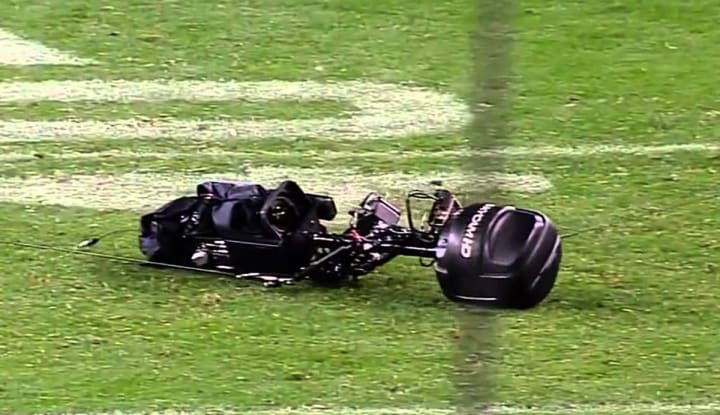Garrett Brown's SkyCam History
Long before drones, there was Garrett Brown's SkyCam.

You've seen the view from high above a football stadium before. But have you ever flown through the goalposts like a football? With SkyCam, a computerized camera originated in the 1980s, that soars through the air on steel cables. Its applications went far beyond sporting arenas, including skiing and other non arena based sports as well as the making of movies, television commercials, and even music videos.
"It gave us almost more freedom than we knew what to do with." said SkyCam's inventor, Garrett Brown. His flying camera could follow a sprinting receiver downfield, hurtle off the edge of a ski jump, or hover above an ice skater performing a spinning dance. Drones were not even an idea in 1985, the year SkyCam debuted. Up until then fans at football stadiums relied on TV cameras mounted on blimps.
"The wonderful thing about Skycam," said Garrett, "is that it let you put a lens where no camera could ever go before." Garrett was a cameraman and computer technician whose inventions had already hit the mark at the movies. In 1978, he won an Oscar for inventing the Steadicam, a camera that remains steady while camera operators run, jump and move around. This invention helped create special effects in movies like Return of the Jedi, where it was used to film the forest chase sequence.
Garrett's invention was a complicated system. Skycam's lightweight camera glides on a set of heavy-duty steel cables attached to four points around a Stadium or other arena. These cables, connected to four microprocessor-controlled motors, move the camera through the air. The whole system was originally controlled with a Sage microcomputer and two joysticks. The Skycam unit weighed around 30 pounds, and could travel through the air at a speed of 25 MPH.
How Skycam Flies

Two pilots (or operators) are needed to work Skycam. One pilot uses a joystick to control the way the Camera flies. The Other operator controls what Skycam will film. This pilot uses another joystick to turn the camera left and right, up and down, and to focus, zoom, and pan the lens. It's like playing a two-handed video game.
The original Sage microcomputer used to control Skycam was not that different from a regular home computer. It had 256K bytes of Random Access Memory—which was actually more than the programmers needed. The Sage was programmed in FORTH, a then advanced language that used five times fewer commands than BASIC.
Skycam's computer program didn't just control camera movements. It also let operators store a particular camera angle in the machine's memory. Once a series of joystick movements was recorded into the computer, these movements could be repeated by simply pressing a button.
The picture from the Skycam camera originally traveled by audio-video microwave signal back to the ground crew. In a split second, this signal sent along fiber optic cables to a camera truck. From there it is transmitted to the TV set. It was way ahead of its time and changed the entire football broadcasting industry.
Cooking Up An Invention

Skycam didn't just come out of thin air. Brown got the idea in 1979 while filming an episode of the TV series Little House on the Prairie. He was talking with Merlin Olsen, the actor and former football star, about how it was impossible to get certain camera angles. This conversation stuck with Garrett, but two years passed before he had a chance to start developing Skycam. His first efforts were simple, but they proved to him that a flying camera system could be built.
He tried the theory out in his kitchen. Garrett used sewing thread and a quarter-inch bolt. It was suspended from a microwave oven, the sink, the kitchen door, and the refrigerator handle. By raising and lowering the different pieces of thread, Garrett discovered he could move the bolt ("camera") to just about any position he wanted. Soon after he formed a company named Skyworks, and raised enough money to build and test a prototype.
Garrett tested the original Skycam at a high school athletic field, and then at Veteran's Stadium in Philadelphia. But those first tests weren't exactly a field day. All kinds of things went wrong. During one test, the camera seemed to have a mind of its own. It flew everywhere but where Garrett wanted it to. A programmer had misplaced one number in the Skycam operating program, and it took all afternoon to find that tiny error. Meanwhile, Garrett recalled, "Yours truly succeeded in crashing the prototype."
SkyCam Problems

Other problems, including difficulty getting all the equipment and cables at the right time, kept Garrett and the Skyworks team behind schedule. The first working model of Skycam was supposed to be ready for the February 1984 Winter Olympics. But bugs in the system kept the Skyworks team from unveiling Skycam during the Winter or Summer Olympic Games.
Brown's team also tried using a Skycam prototype in early 1984 during the making of Robert Redford's baseball film, The Natural. Redford wanted Skycam to follow the flight of a home run. But the frame that held the camera wasn't solid enough. The picture jiggled and the film footage couldn't be used. The new version of Skycam has a sturdier frame.
Even with the new improved Skycam, a looming problem remained. All that equipment hanging in mid-air could get in the way, especially during football games when there's a high kick or pass.
Precautions were eventually taken and the National Football League (NFL) set up rules that affect where and how Skycam could be used during a game. For instance, if the camera is positioned behind the quarterback, Skycam must be 20 feet above the ground. If the camera is over the line of scrimmage, it must be at least 50 feet off the ground. And if it is over the defensive team, it must be 75 feet above the field.
You didn't want a ballplayer seeing the ball and the camera approaching at the same time. You didn't want him trying to catch the wrong one.
About the Creator
Eddie Wong
Lives in Malibu, California. Loves movies. Cutting expert, lover of Final Cut Pro 7. Parents wanted him to be a doctor, but he just wants to edit.






Comments
There are no comments for this story
Be the first to respond and start the conversation.